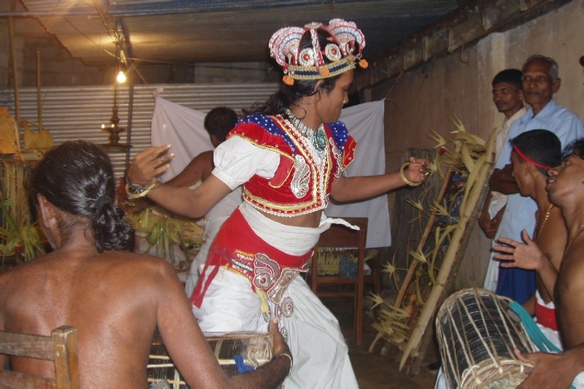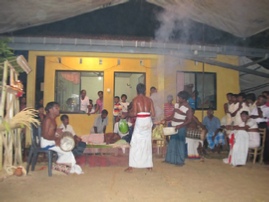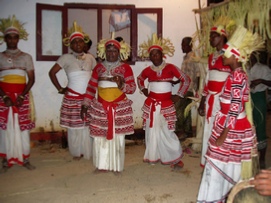© 2023 Dr. M. Sheppard
Devil Dancing /Tovil
There are 3 main types of practitioners who mediate between mankind and the supernatural world of the demons, ghosts and deities. These practioners can be involved in the treatment of a patient whose illness is attributed to an occult cause. These are:
1 The Astrologer and clairvoyant – read the all-
2 The Kapua – intercedes with a Deity at the Deity’s shrine. They contact the Deity and entreat them to stop illness, epidemics or misfortunes that they have sent. The Kapua is responsible for taking care of the Shrine to the Deity and making the daily offerings. They will also become entranced (often following the inhalation of dummala smoke) and in this state will prophesy to the supplicant who is consulting them. (See Deity and Pattini Ceremonies Sections for more details of the treatment of problems attributed to Deities). The Kapua may well recommend a consultation with -
3 The Edura with a view to a Devil Dance/Tovil.
Whereas the astrologer, clairvoyant and Kapua can diagnose a problem caused by demons, the Exorcist – Edura (see below) removes it from the patient.
These Tovil Dances held to cure the patient are very spectacular.
Many people still consult tovil dancers if they or family members become sick or they suffer from misfortunes, to mediate for them between mankind and the supernatural world.
When a person is afflicted and demon sickness is suspected as the cause, a Tovil Dancer is called to diagnose/divine the problem and the cure. During his initial consultation he will take the case history from the patient and/or relatives regarding the symptoms, when the problem started, at what time of day etc. In addition he will often divine by lime cutting. A number of limes are held one by one against the patient’s head with betel nut cutters. The Edura recites a mantra and then cuts the lime in half before tossing the halves into a clay pot of clear spring water. From the way the halves settle in the water (showing the insides or outsides uppermost) the Tovil Dancer can divine, together with the case history, the cause of the affliction and the appropriate cure i.e. which demon or demons is/are afflicting the patient.
There are various types of Tovil Dances (more details of which will follow in the various sections). As they take time to organise the “patient” will often be given a temporary “fix” for protection. This typically consists of a plaited cord steeped in various natural substances such as coconut oil, yellow root powder etc. over which the Tovil Dancer has recited Holy Mantra (prayers). This cord is then tied around the neck, upper arm, waist or leg.
The family is then given a list of the requirements for the specific Tovil Dance offerings and structures and constructions that will be used to make the offerings to the Demons afflicting the patient. These consist of various Ayurvedic plants and leaves used in decoration and for the medicated water, banana tree trunk stems, coconuts, leaves, clay pots for the pure water, clay oil lamps, coconut lamp oil, a cock etc.
Background
Sickness, disease and bad luck is often attributed to the disease causing demons who are believed to be present and strike their victim particularly at night.
Although Buddha preached equality, caste is still respected. The world of the occult is also organised into a hierarchy. Buddha is at the zenith, next the Deities and below them the demons who are also in hierarchical order according to their origin. The legends of the disease causing demons is sung during the Devil Dance ceremonies and are also recited during the curing mantras, to free the afflicted from the demon sickness. The history and origins of the various dances and their success in curing often mythological patients is sung, danced and mimed during these ceremonies

These following and highly illustrated descriptions in the following sections are the results of my observations, visits to and participation in curing ceremonies 1994-
For much more explanation, reading and Anthropological and Sociological detail see for example:
Paul ‘Wirz “Exorcism and the Art of Healing in Ceylon” 1954
Bruce Kaferer “A Celebration of Demons* 1983
Gananath Obeysekere “The Cult of the Goddess Pattini” 1984
See also internet searches under these headings.
All of these volumes provide extensive reading lists.
The ceremonies I attended in the mid 1990s up to 2015 followed in the main the general format as those described by Wirz and Kapferer at a much earlier period. However as both social scientists point out there are variations between different groups of practitioners. The groups conducting the ceremonies I attended referred to the ceremonies as mostly Mahasona Ceremonies or Sanni 18s.

